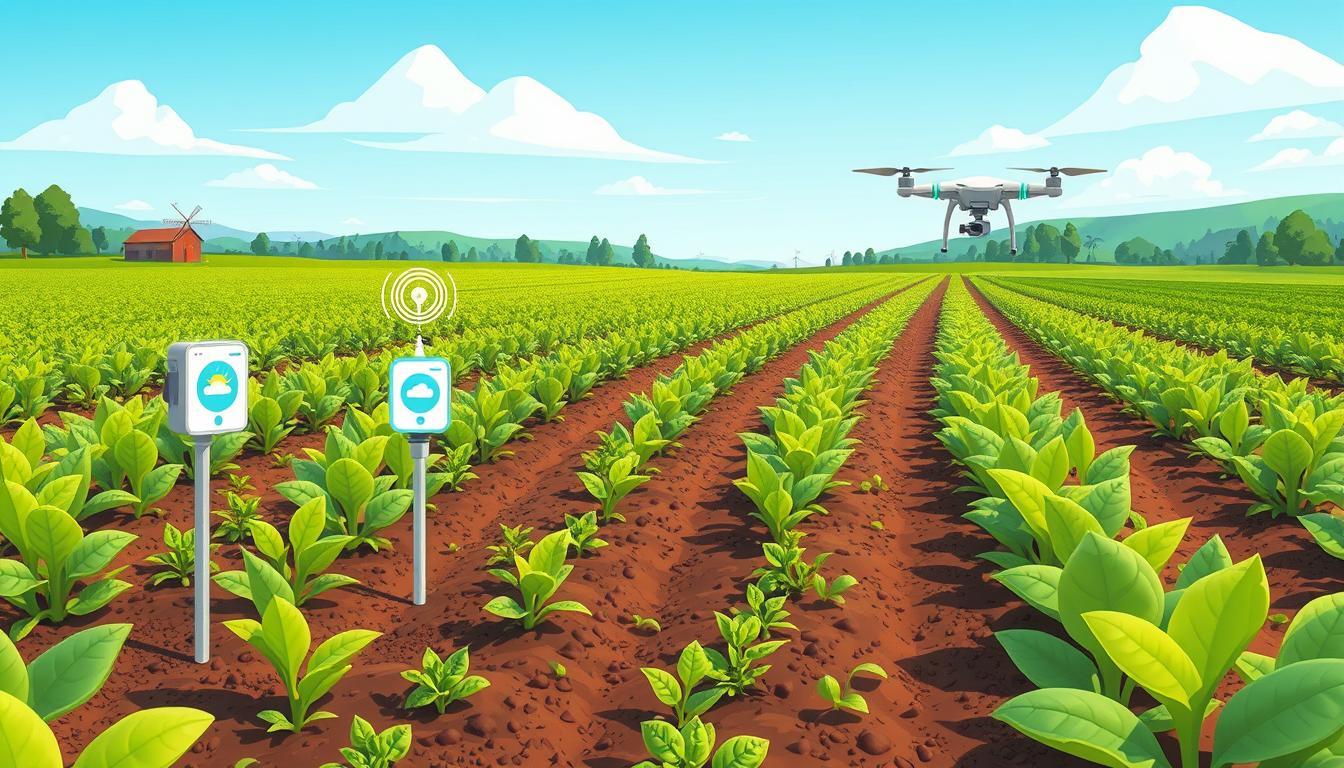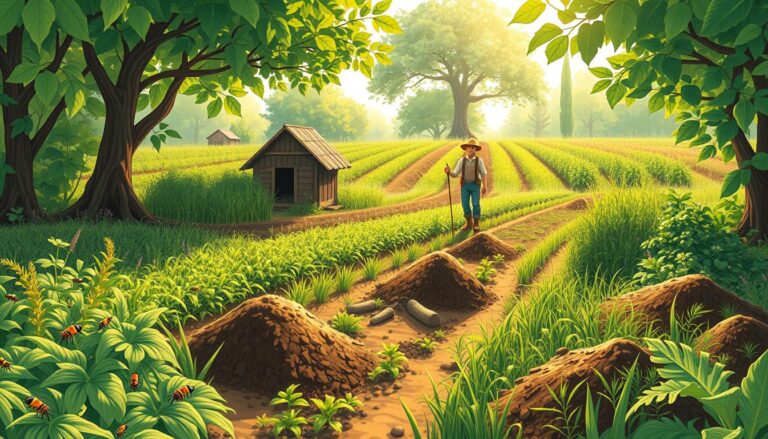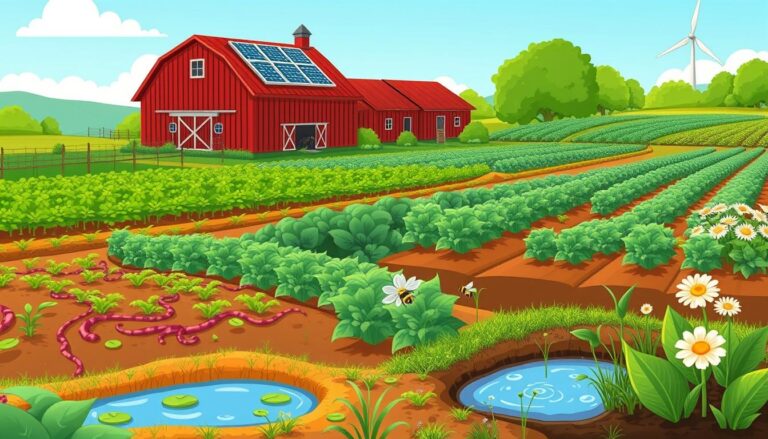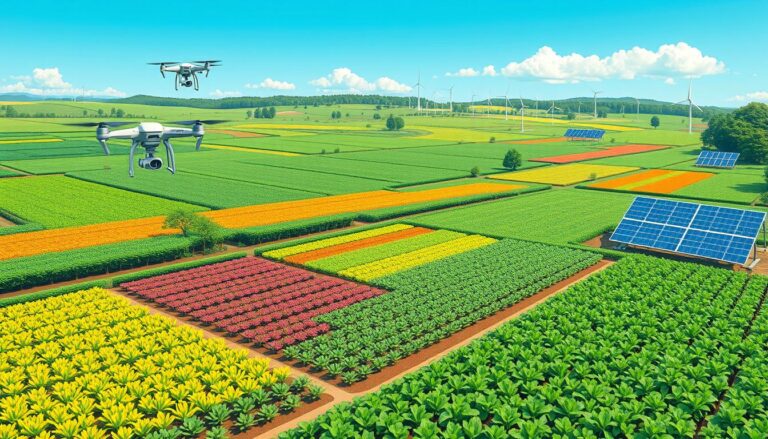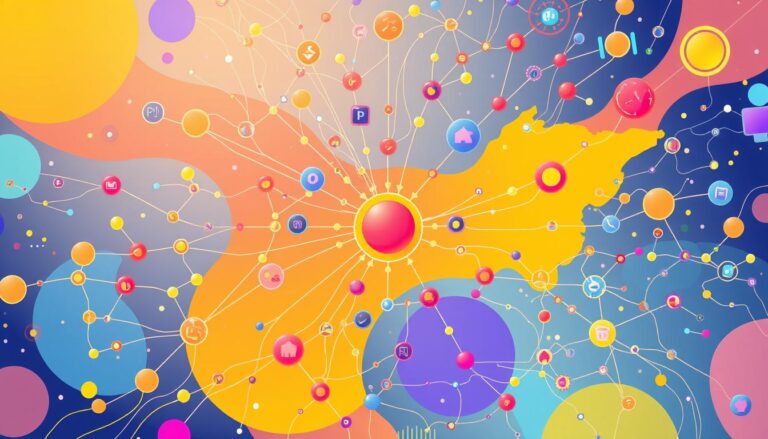IoT Agriculture Sensors: Transforming Modern Farming
Welcome to the world of precision agriculture. Here, IoT sensors and AgTech solutions are changing farming forever. Today, IoT agriculture sensors are easy to get, helping farmers grow more, use less, and waste less. They use smart farming tech to gather and analyze data in real-time, making farming better.
The impact of IoT on farming is huge. The precision agriculture market is expected to hit $27.81 billion by 2031, growing 12.9% each year. IoT sensors track soil moisture, humidity, and more, giving farmers the info they need. From drones to wearable devices, IoT is changing farming in many ways.
IoT farming is making farming more productive and green. It helps farmers use water and fertilizers better, cutting waste and harm to the environment. It also lets farmers check on animal health quickly, helping them breed better. IoT is truly changing farming for the better.
Key Takeaways
- IoT agriculture sensors are transforming modern farming by enabling precision agriculture and smart farming practices.
- Connected drones, wearable IoT devices, and smart greenhouses are among the key applications of IoT in agriculture.
- IoT sensors measure crucial factors such as soil moisture, humidity, temperature, and nutrients to optimize agricultural management and production.
- The adoption of IoT in agriculture is increasing productivity, efficiency, and sustainability while reducing waste and environmental impact.
- Challenges in implementing IoT agriculture sensors include connectivity issues, energy requirements, maintenance complexities, and data security concerns.
Understanding IoT Agriculture Sensors
The Internet of Things (IoT) has changed farming. It lets farmers track and care for their crops and animals better. IoT uses sensors, gateways, and software to collect and analyze data in real-time. This helps farmers make smart choices and improve their work.
What is IoT in Agriculture?
IoT in farming includes many technologies to help manage farms better. Farmers use sensors in fields and connect them to gateways. This way, they get data on soil moisture, weather, crop health, and animal behavior.
This data is then analyzed using special software. It gives farmers insights to boost their yields and use resources wisely.
Key Components of IoT Sensors
IoT sensors are the heart of agricultural technology. They collect important data from the field. These sensors can handle tough weather, thanks to their IP67 rating.
Some key sensors include:
- Soil moisture sensors
- Weather sensors
- Crop health sensors
- Livestock monitoring sensors
IoT systems also need gateways for data sharing. They use networks like cellular, LoRaWAN®, Sigfox, and Bluetooth® for global connectivity.
Benefits of IoT Sensors for Farmers
IoT sensors bring many advantages to farmers. They help farmers respond quickly to changes in crops and animals. They also help farmers use resources like water and fertilizer more efficiently.
- Improved responsiveness to crop and livestock variabilities
- Optimization of yields through precision farming techniques
- More efficient use of resources like water and fertilizer
- Enhanced animal welfare through real-time health monitoring
- Increased overall productivity and profitability
Farmers can make their operations better by using IoT. This leads to more sustainable farming. As IoT technology gets better, it will help farmers even more.
Types of IoT Agriculture Sensors
IoT agriculture sensors have changed farming for the better. They help farmers use water and soil better. This leads to healthier crops and more food.
Soil Moisture Sensors
Soil moisture sensors are key for better watering. They check how wet the soil is. This helps farmers save up to 30% of water.
The Renke soil moisture sensor is a top pick. It’s known for being reliable and accurate.
Weather Sensors
Weather sensors, like those for temperature and humidity, are very useful. They help farmers know the best conditions for growing crops. This can boost productivity by up to 25%.
Crop Health Sensors
Crop health sensors, like optical and biosensors, spot problems early. They help farmers avoid losing crops. This can increase yields by 15%.
Biosensors give real-time info on plant health. This helps farmers make quick decisions. It also makes crops more resilient by up to 20%.
Livestock Monitoring Sensors
Livestock monitoring sensors are crucial for animal care. They help track animals and their health. This ensures animals are safe and well cared for.
GPS sensors are key for tracking animals. They help farmers keep their animals safe. They also help with efficient farming.
How IoT Sensors Improve Crop Management
IoT sensors have changed how we manage crops. They help farmers use resources better and grow more crops. These sensors collect data in real-time, making it easier to make decisions and predict what will happen.
Real-Time Data Collection
IoT sensors collect data right from the farm. Farmers can check on their crops from anywhere. They can see things like soil moisture and temperature.
This helps farmers find problems like nutrient issues or pests fast. They can fix these problems before they get worse.
Enhanced Decision-Making
The data from IoT sensors helps farmers make better choices. They can see how their crops are doing and what they need. This leads to better use of water, fertilizer, and pest control.
Using IoT and special software helps farmers keep their crops healthy. This way, they can grow more without wasting resources.
Predictive Analytics
Predictive analytics use sensor data to forecast yields and spot problems. AI helps farmers find issues like pests or nutrient shortages early. This lets them act fast to protect their crops.
By looking at past data and current conditions, farmers can plan better. They can predict how crops will grow and use resources wisely. This leads to more profit and less harm to the environment.
The future of IoT in farming is exciting. We’ll see better, cheaper sensors and more advanced tools. Farmers will grow more, with better quality crops, and be more sustainable.
The Role of Data Analytics in IoT Agriculture
IoT sensors collect a lot of data, but it’s useless without analysis. Agricultural data analytics turns this data into useful insights for farmers. With advanced analytics, farmers can make better decisions, increase yields, cut costs, and boost farm efficiency.
Data analytics in precision farming uses predictive modeling, machine learning, and data visualization. These tools help farmers spot patterns and trends in the data. This gives them insights into crop health, soil, and weather.
Data Visualization Techniques
Data visualization is key in agricultural data analytics. It makes complex data easy to understand. Techniques like dashboards, heat maps, and scatter plots are used in precision farming.
- Dashboards: Interactive dashboards show key data at a glance. Farmers can see crop health, soil moisture, and weather conditions easily.
- Heat maps: These use colors to show data patterns in fields. Farmers can spot areas needing attention or action.
- Scatter plots: These plots show how different variables relate. For example, they can show how soil moisture affects crop yield.
Actionable Insights for Farmers
Agricultural data analytics gives farmers insights to make better decisions. These insights can help farmers optimize their farming practices. Here are some examples:
| Insight | Action |
|---|---|
| Soil moisture levels are low in specific areas | Adjust irrigation schedules to optimize water usage |
| Nutrient deficiencies detected in crops | Apply targeted fertilizers to address specific nutrient needs |
| Pest infestation predicted based on weather patterns | Implement proactive pest control measures to minimize crop damage |
| Optimal harvest time determined based on crop maturity data | Schedule harvesting to maximize crop quality and yield |
By using these insights, farmers can manage their crops better, reduce waste, and increase profits. As Dr. John Smith, a leading expert in precision farming, says:
“Data analytics is the key to unlocking the full potential of IoT sensors in agriculture. By turning raw data into actionable insights, farmers can optimize every aspect of their operations, from planting to harvesting, and everything in between.”
Challenges in Implementing IoT Agriculture Sensors
IoT sensors in agriculture bring many benefits but also face challenges. Farmers must think about costs, data security, and how well these systems work with what they already have.
Technology Costs and Accessibility
High upfront costs are a big problem for using IoT sensors in farming. The cost to buy and set up these devices can be too much for many farmers. The market for IoT in agriculture was $13.76 billion in 2022, with a growth rate of 9.9%.
But, the cost is still a worry for those with small budgets. Also, getting internet in rural areas is hard. This makes it tough to connect IoT devices in these places.
Data Security Concerns
IoT devices send out a lot of sensitive data. This makes keeping data safe and private very important. Farmers need to protect their data from hackers.
“With the growing use of IoT in agriculture, data privacy and security must be a top priority to ensure the integrity and confidentiality of sensitive farming data.”
Integration with Existing Systems
IoT sensors also need to work well with what farmers already use. But, different devices often don’t talk to each other easily. This makes using the data from these sensors hard.
To solve these problems, farmers should think about what they need and can afford. Working with tech companies and getting advice from experts can help. This way, they can use IoT sensors effectively in their farming.
Future Trends in IoT Agriculture Sensors
The world’s population is expected to hit 9.7 billion by 2050. This growth highlights the urgent need for new farming technologies. IoT in agriculture is set to change farming, thanks to better sensors, green farming, and AI. These advancements aim to boost crop yields, cut down on environmental harm, and secure food for the future.
Advances in Sensor Technology
IoT sensors are changing farming fast. They’re getting smaller, cheaper, and more durable. This lets farmers collect data much faster than before.
These sensors track water levels, soil quality, and crop growth. For example, wireless soil moisture sensors can increase yields by up to three percent. Also, drones and satellites provide insights into crop health, helping farmers use precision agriculture.
Sustainable Farming Practices
IoT is key to sustainable farming. It supports precision agriculture, which boosts efficiency and cuts down on waste. Technologies like GPS-guided tractors and sensor-equipped machines help farmers tailor their work to each farm.
Water-saving tech, like drip irrigation, reduces water use. Climate-resilient crops, made with DNA sequencing and CRISPR, improve pest resistance and drought tolerance. This reduces the need for harmful chemicals and protects the environment.
The Impact of AI and Machine Learning
AI and machine learning are transforming agriculture. They use IoT data to offer insights and make decisions automatically. This helps farmers use land better and adapt to changes quickly.
Companies like ICL Group are backing startups in AgTech. ICL’s Agmatix offers data for better farming, and ICLeaf’s X-ray tech analyzes nutrients precisely. As AI and machine learning improve, so will sustainable and precise farming.
Source Links
- IoT in Agriculture: How Technology Is Transforming Farming Practices
- Transforming the Fields: How IoT and Smart Agriculture Sensors are Reshaping Farming – SenTec
- IoT Agricultural Sensors & Smart Farming Tracking Equipment
- An Ultimate Guide to the Role of IoT Sensors in Agriculture
- Sensors in Agriculture: What Are They All About? | Simon IoT
- What types of sensors are used in precision agriculture?
- 7 types of agricultural sensors driving the smart farming revolution
- List Of Agriculture Sensors,Advantages Of Agriculture Sensors – Renke
- How IoT Enhances Crop Health Monitoring for Precision Farming
- Smart Farming System using IoT for Crop Growth with Agriculture Sensors – NCD.io
- IoT in Agriculture: 10 Applications to Boost Efficiency and Maximize Yields
- The Role of Data Analytics in Modern Agriculture
- How IoT in Agriculture is Transforming the Farming Landscape
- IoT in Agriculture: 9 Technology Use Cases for Smart Farming (and Challenges to Consider)
- Challenges and Solutions in Implementing IoT in Agriculture
- IoT in Agriculture | Use cases, Benefits and Challenges | A3Logics
- The Future of Agricultural Industry Using IoT | TEKTELIC
- Agtech: Future Trends and Emerging Technologies

